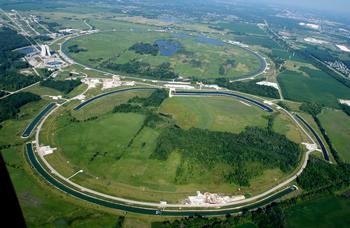A Friendly Competition in Science

Selcuk Cihangir
Fermilab
A friendly competition is raging these days between Europe and the USA. It is taking place in the arena of answering the question: “why does matter exist?” Knowing the answer to this question may not “matter” to some, as it did not matter to many people why apple fell from the tree. It did to Isaac Newton. Thanks to him (and many others), we can now explore and utilize the outer space. In 1980’s it did not matter to a lot of people that a handful of computers could share data over telephone lines; the idea that took roots in an experimental particle physics collaboration, which took us to the internet era.
To answer this profound question about matter, physicists use huge microscopes to study tiny objects. The tiny objects are the sub-atomic elementary particles, some of which make up the matter we can see, touch and smell. The huge microscopes are the proton (one of the constituents of the ordinary matter) and antiproton (proton’s partner in anti-matter universe) accelerators. One of such accelerators is in Switzerland, Europe, called CERN (European Organization for Nuclear Research) [1]. The other is in the USA, in Batavia, Illinois, called Fermilab (Fermi National Accelerator Laboratory) [2]. Ordinary microscopes use light (photons, particles with no mass) to probe the tiny objects like microbes. Accelerators use elementary particles to probe the matter. Photons come with certain range of energy from their sources, like light bulbs or the sun. We need to energize (accelerate) the elementary particles and collide them in probing the matter.
The CERN accelerator is presently being commissioned. When it is in full operation, a few years from now, it will be 7 times more energetic than the accelerator in Fermilab. It will also produce more data per second because it will collide beams of particles 100 times more dense. The Fermilab accelerator, on the other hand, is operational. It is producing events probing the matter. The main objective is to answer the question: “Why does matter exist? Asked differently: “Why do elementary particles have mass?”
Standard Model (SM), a theory that describes our understanding of all matter (particles), requires a particle called Higgs. It interacts with other particles to cause them to attain mass. Without Higgs, they would all stay in energy form. That is why the Higgs particle is called “God Particle” by some [3].
The competition is then a race to detect the Higgs particle first, either at Fermilab or at CERN. The SM theory does not predict the mass value of Higgs, but there are reasons for it to be in the range of from 114 GeV to about 200 GeV (proton’s mass is 1 GeV in this unit). So, it can be found at Fermilab. That is what the physicists at Fermilab are trying to do: discover the Higgs particle at two detectors they built, namely D0 [4] and CDF [5]. They are operated 24 hours a day, 7 days a week by approximately 350 physicist and engineers each. If they do not, or cannot, CERN will discover it within a year of its full operation. So far, all Fermilab could do was to set a limit on Higgs’ mass value at a certain sensitivity level of its discovery at that mass value. When Higgs is produced at a proton-antiproton, or proton-proton collisions, it decays into other particles. These “events” are buried under many other events that have the same signature on the detectors. The Higgs events have to be sieved out from these other events, which is the challenge to all in this discovery adventure.
It will be a prestigious achievement for the USA and Fermilab if the Higgs particle is discovered at Fermilab. It will fill a big hole in the wall of knowledge the humanity has been building over the ages. In a different point of view, when the first director and one of the founders of Fermilab, Robert R. Wilson, was asked in a congressional hearing for funding Fermilab’s construction, “What will its contribution be to the defense of the USA?”, he answered “We do not know what its contribution to the defense of the USA will be, but we know that it will make the USA worth more to defend”.
References:
[1] http://public.web.cern.ch/public/
[2] http://www.fnal.gov/
[3] The God Particle, by Leon Lederman, A Delta Book published by Dell Publishing, 1993.
[4] http://www-d0.fnal.gov/
[5] http://www-cdf.fnal.gov/